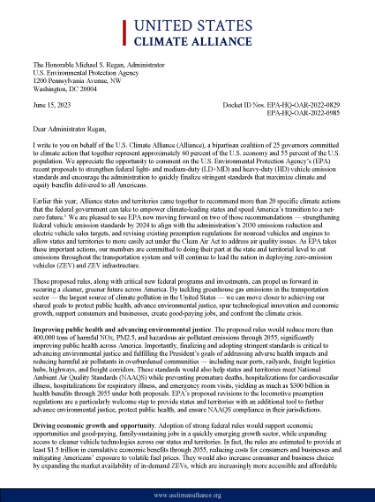Home / U.S. Climate Alliance Calls for Stringent Final Vehicle Emission Standards
- Letter
U.S. Climate Alliance Calls for Stringent Final Vehicle Emission Standards
June 15, 2023
EPA’s recent proposals to strengthen federal light- and medium-duty (LD+MD) and heavy-duty (HD) vehicle emission standards, along with critical new federal programs and investments, can propel us forward in securing a cleaner, greener future across America.
Earlier this year, Alliance states and territories came together to recommend more than 20 specific climate actions that the federal government can take to empower climate-leading states and speed America’s transition to a net-zero future. We are pleased to see EPA now moving forward on two of those recommendations — strengthening federal vehicle emission standards by 2024 to align with the administration’s 2030 emissions reduction and electric vehicle sales targets, and revising existing preemption regulations for nonroad vehicles and engines to allow states and territories to more easily act under the Clean Air Act to address air quality issues.
As EPA takes these important actions, our members are committed to doing their part at the state and territorial level to cut emissions throughout the transportation system and will continue to lead the nation in deploying zero-emission vehicles (ZEV) and ZEV infrastructure.
By tackling greenhouse gas emissions in the transportation sector — the largest source of climate pollution in the United States — we can move closer to achieving our shared goals to protect public health, advance environmental justice, spur technological innovation and economic growth, support consumers and businesses, create good-paying jobs, and confront the climate crisis.
About the Alliance
Launched in 2017 by the governors of Washington, New York, and California to help fill the void left by the U.S. federal government’s withdrawal from the Paris Agreement, the Alliance has grown to include 24 governors from across the U.S. representing approximately 60 percent of the U.S. economy and 55 percent of the U.S. population. Governors in the Alliance have pledged to collectively reduce net greenhouse gas emissions by at least 26-28 percent by 2025, 50-52 percent by 2030, and 61-66 percent by 2035, all below 2005 levels, and collectively achieve overall net-zero greenhouse gas emissions as soon as practicable, and no later than 2050.
The Alliance’s states and territories continue to advance innovative and impactful climate solutions to grow the economy, create jobs, and protect public health, and have a long record of action and results. In fact, the latest data shows that as of 2023, the Alliance has reduced its collective net greenhouse gas emissions by 24 percent below 2005 levels, while increasing collective GDP by 34 percent, and is on track to meet its near-term climate goal of reducing collective greenhouse gas emissions 26 percent below 2005 levels by 2025.
###
